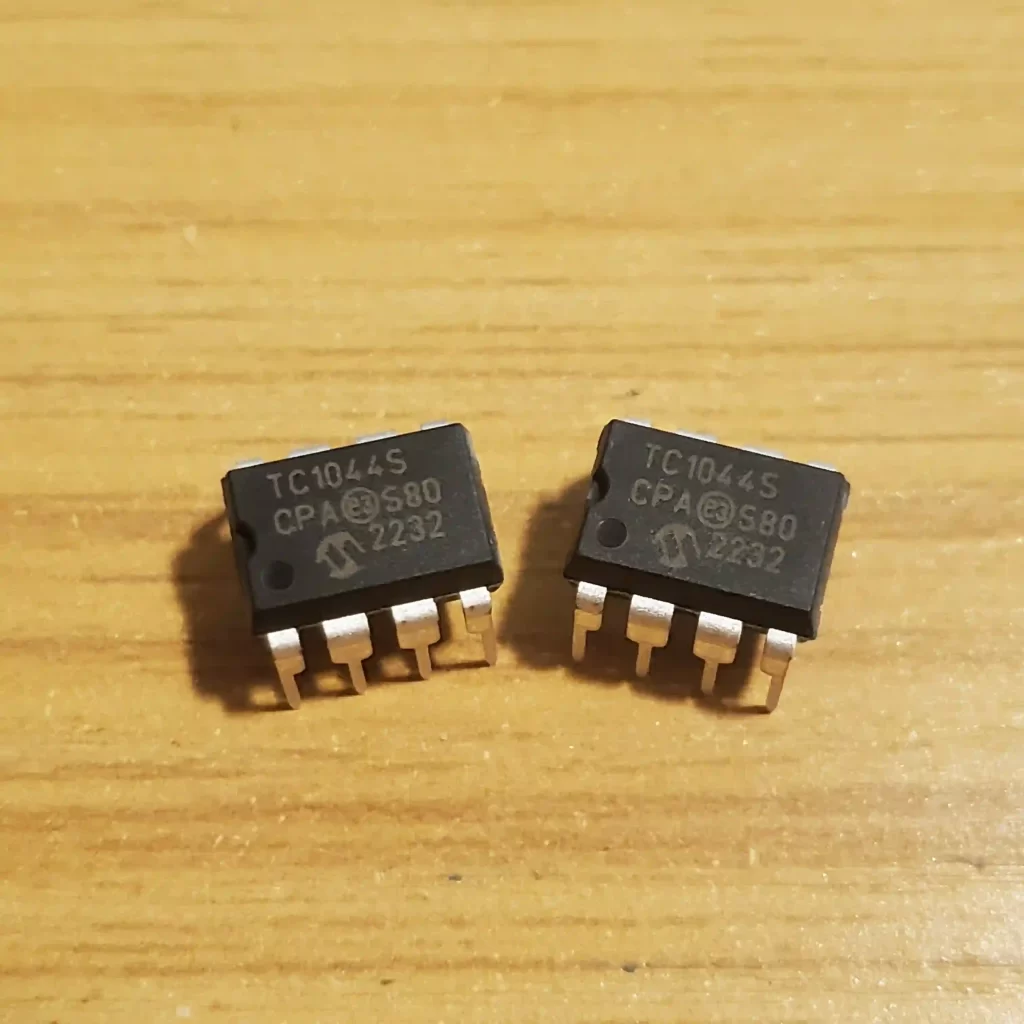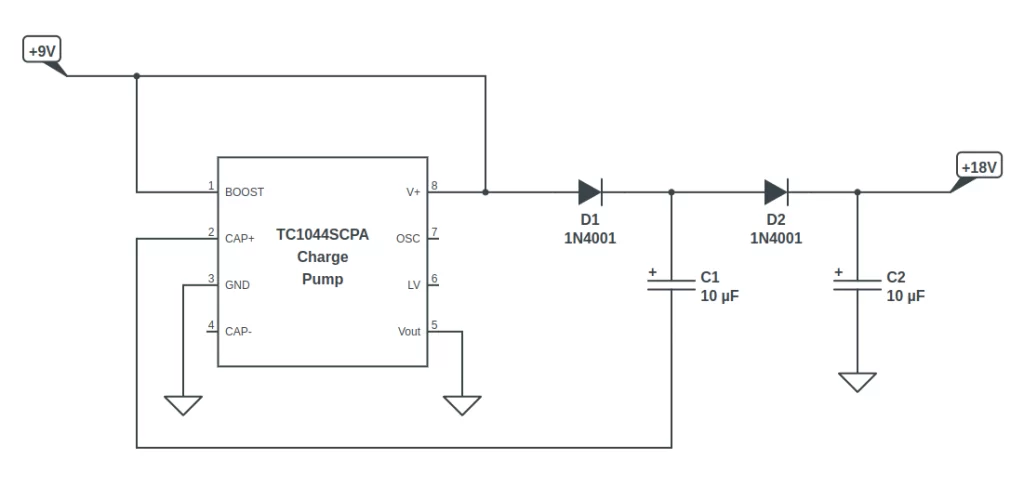
As a member of the Reverb Partner Program and as an Amazon Associate, StompboxElectronics earns from, and is supported by, qualifying purchases.
Disclaimer: Stompbox Electronics and/or the author of this article is/are not responsible for any mishaps that occur as a result of applying this content.
What is a Charge Pump?
A charge pump is an integrated circuit (IC) that is used to convert from one voltage to another.
As an example, let’s say you want to build a circuit that runs on +18Vdc, but you want to power it using a +9Vdc adapter. You can use a charge pump IC to double the +9Vdc supply to yield +18Vdc.
Charge pumps are usually purchased in the form of an integrated circuit. One example, and the focus of this article, is the TC1044S. The TC1044S is a DC-to-DC Voltage Converter manufactured by Microchip, and it’s very common in guitar pedal circuits for DC voltage conversion.

Uses for Voltage Doublers in Guitar Pedals
Voltage doublers are circuits that take in a DC supply voltage Vsupply and convert it into an output voltage Vout that is twice as large as the supply. In guitar pedals, a charge pump IC is used for building voltage doublers.
There are at least 3 uses for voltage doubler circuits in guitar pedals. They are:
- Compatibility with Standard Power Adapters
- Increased Headroom
- Building Klon Circuits
Compatibility with Standard Power Adapters
You may want to design a guitar pedal that uses +18Vdc. At the same time, you don’t want to force people to use the +18Vdc port on a power supply, nor do you want to require the user to use a +18Vdc adapter.
With a charge pump IC, you have the option to use a +9Vdc voltage source by doubling the voltage inside the pedal with a voltage doubler circuit. In this way, you can run a circuit designed for +18Vdc with a +9Vdc voltage source.
Increased Headroom
Many overdrive and distortion circuits utilize operational amplifiers (op amps) that are designed with maximum voltage ratings higher than +18Vdc. The circuits they’re used in are usually designed for a +9Vdc supply voltage.
If you’re careful about not hitting the maximum rating of your charge pump then you can use a voltage doubler to increase the supply voltage to 18V. This potentially results in more headroom in overdrive circuits.
Providing Two Supply Voltage Levels (the Klon Method)
The most popular usage of a voltage doubler in the DIY guitar pedal space is the Klon Centaur overdrive. The schematic shows a charge pump being used to provide two voltage sources to two separate sections of the circuit.
The clipping/overdrive section is powered by +9Vdc, while the Tone and Summing circuits are powered by +18Vdc, produced by a voltage doubler (see Electrosmash).
A Word of Caution
Please keep in mind that other chips and electrolytic capacitors inside of an existing circuit may not be able to take the increased voltage produced by a voltage doubler. Always make sure that the doubled voltage is below the maximum voltage ratings of all electrolytic caps and ICs.
When in doubt, seek guidance from an experienced technician before adding a voltage doubler to your design.
Charge Pump Characteristics
There are many charge pumps to choose from, and it helps to know how to differentiate one from another. To do so, you need to get familiar with the characteristics of charge pumps. Specifically:
- Maximum Voltage
- Switching Frequency
- Output Voltage vs. Output Current (Circuit Loading)
This article focuses on the TC1044S, so we will use it’s datasheet as the example.
Maximum Voltage
Charge pumps have a maximum voltage at which they are able to operate, which is specified in the Absolute Maximum Ratings section of the datasheet. For the TC1044S, the maximum voltage at which it can operate is 12Vdc. Attempting to operate the TC1044S with supply voltages over 12Vdc will damage the chip.
Here is a list of maximum voltage ratings for various charge pumps:
Common Maximum Voltage Ratings for Various Charge Pump ICs
| Device | Maximum Rated Voltage |
|---|---|
| TC1044S | 12V |
| LT1054 | 15V |
| TC962 | 18V |
| MAX1044 | 10V |
| ICL7660 | 10V |
Switching Frequency
Charge pumps operate at a default switching frequency specified by the manufacturer. The default switching frequency for the TC1044S is 10kHz. Generally, a lower switching frequency corresponds to a more efficient operation.
10kHz is pretty low for us guitar pedal enthusiasts. We’re operating in the audio band, which is generally considered any frequency between 20 Hz and 20kHz. A charge pump that inherently switches at 10kHz (like the TC1044S) will induce an audible whine in our circuit, making it unusable.
Luckily, charge pump manufacturers have included a BOOST option that allows us to increase the switching frequency to a level above the audio range. The tradeoff is a less efficient charge-pump, but this is generally OK for circuits pulling less than around 50mA.
Common Switching Frequencies for Various Charge Pump ICs
| Device | Default Switching Frequency | Boosted Switching Frequency |
|---|---|---|
| TC1044S | 10kHz | 45kHz |
| LT1054 | 25kHz | Max: 35kHz* |
| TC962 | 12kHz | 24kHz |
| MAX1044 | 5kHz | 30kHz** |
| ICL7660 | 10kHz | 60kHz** |
**The MAX1044/ICL7660 datasheet specifies the boosted frequency is 6x the default.
Voltage Doubler Circuit & Schematic
A basic charge pump-based voltage doubler is shown in Figure 10.2 using the TC1044SCPA.
The circuit consists of two 1N4001 diodes (D1 and D2) and two capacitors (C1 and C2). The circuit is adapted straight from the TC1044S datasheet (Page 6, Figure 8) with the exception of the required BOOST pin connection.

During a “charge cycle,” the charge pump utilizes C1 to produce a voltage of 9V – Vf. Vf is the forward voltage drop of the diode D1 (which is 1.1V for the 1N4001). So, the voltage appearing after D1 should read around 7.9V.
Next, a transfer cycle occurs which adds the voltage across C1 to the supply voltage. That voltage shows up through D2, thus producing an output voltage of 7.9V + 9V – 1.1V = 15.8V.
I know what you’re thinking…that output voltage was supposed to be +18Vdc. What gives??
Well, if it weren’t for those diode voltage drops we wouldn’t have this problem. So, let’s use a different diode: the 1N4448, which has a maximum forward voltage of 0.72V. With the new 1N4448 diodes, the output voltage comes out to a worst-case 16.56V. With a typical value for the voltage drop (0.65V) we get around 16.7V.
That’s a little better, but it’s not 18V. Luckily, for guitar pedals, we don’t need to be so precise. The extra 1-2 volts aren’t really needed for most applications. The headroom is already huge when compared to a clean guitar signal, which lives in the hundreds of mV range.
Voltage Multiplier Equation
The TC1044S datasheet gives you a handy equation to calculate the output voltage of the voltage doubler.

Voltage Doubler Parts List
Use the following parts to build the voltage doubler circuit shown above. Remember to not exceed the maximum supply voltage rating of 12Vdc for the TC1044.
| Parts | Qty |
|---|---|
| TC1044SCPA | 1 |
| 10uF Electrolytic Capacitor | 2 |
| 1N4001 | 2 |
| 1N4448 (Optional) | 2 |
TC1044S Alternatives
The TC1044S is a “pin-compatible upgrade” to the TC7660, according to the TC1044S datasheet. You can use these two chips interchangeably.
The Maxim Integrated MAX1044 and ICL7660 are pin-to-pin compatible with the TC1044. However, keep in mind that the maximum voltage for both MAX1044 and ICL7660 is 10V. I recommend going through their respective datasheets and comparing them with your requirements before committing to any replacements.
Alternatives that do not have pin-for-pin compatibility with the TC1044S include the Texas Instruments LT1054 and TC962. Always read the manufacturer’s datasheet before committing to these as potential alternatives.
Guitar Effects Design in 48 Circuits or Less
The 48 Circuits or Less article series serves to close the gap between DIY guitar effects design and guitarists interested in the craft by uniquely curating the most important aspects of DIY guitar effect circuit design. This post is part of the 48 Circuits or Less series. View more articles in this series here.
Meet the Author:

Hi, I’m Dominic. By day, I’m an engineer. By night, I repair and modify guitar effects! Since 2017, I’ve been independently modifying and repairing guitar effects and audio equipment under Mimmotronics Effects in Western New York. After coming out with a series of guitar effects development boards, I decided the next step is to support that community through content on what I’ve learned through the years. Writing about electronics gives me great joy, particularly because I love seeing what others do with the knowledge they gain about guitar effects and audio circuits. Feel free to reach out using the contact form!
The Tools I Use
As a member of Amazon Associates, Stompbox Electronics earns and is supported by qualifying purchases.















